Notes: Millers Dale Station was situated on what became the Midland Railway’s (MR) main line between Ambergate and Manchester Central.
Millers Dale station opened on the 1st of June 1863 on the MR line that had been authorised in May 1860 and completed in its entirety from Rowsley to Buxton by the stations opening date. Ever since the 1840s there had been a desire by the MR to reach the important industrial town of Manchester. Inter company rivalry, finance and landowner objections had all delayed things and it was only the possibility that rival companies might build a route between Derby and Manchester that finally moved the MR to get their Act of 1860. The line between Rowsley and Buxton was only the first stage though as on the 1st February 1867 a further line opened from a point a couple of miles to the west of Millers Dale to New Mills. This gave the MR a route stretching all the way to Manchester which it had long desired.
| Millers Dale Station was located a short distance to the southwest of its village namesake. When the station opened it was provided with two platforms. A substantial stone building which included a two storey station master's house was provided on the north side of the line on the southbound platform. The building was also provided with a canopy. A goods shed was |
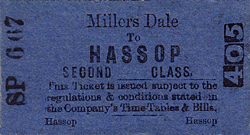 |
provided to the west of the station buildings again on the north side of the line and the station had a 2-ton crane. It was served by sidings that passed behind the southbound platform. There were a number of private sidings including the Buxton Central Lime Co., Millers Dale Lime Co., Newton Chambers & Co and other companies.
Only simple waiting facilities were provided on the northbound platform. At first the station was served by trains running between Buxton and points to the south of Ambergate, including London. However with the opening of the line to New Mills on the 1st February 1867, Millers Dale station took on a much more important role than might be expected for a station that was 800 feet above sea level and in a very remote location. A subway linked the platforms was built in 1884..
 |
From the 1st February 1867 most of the MR main line express services running through Millers Dale were scheduled to stop there. The reason for this was that the MR wished to offer a fast service from Manchester, and a few years later from Liverpool, to London that was competitive with its arch rivals the London North Western Railway (LNWR). Because of the way the |
MR main line had developed Buxton had ended up being on a branch. If the MR ran its long distance express services into Buxton, a terminus station, it would then have to reverse them out again wasting valuable time. So it was decided that express trains would bypass Buxton. In order to provide the citizens of the spa town with the opportunity to travel on express services Millers Dale station was chosen to be an interchange station. The idea was that Buxton Passengers would travel to and from Millers Dale on local services. At Millers Dale express services would be available. To assist the people of Buxton even further, a shuttle service was introduced which ran only between Buxton and Millers Dale and which gave direct connections into main line services.
Some through coaches to London from Buxton did run but they were brought to Millers Dale and then attached to, or detached from, the express train
| So despite its isolated position, Millers Dale became a very busy station. In April 1875 works were authorised for the creation of a single storey wooden waiting shelter on the northbound platform. The platform was ready for use by March 1877. Also in 1875 a line was laid at the rear of the northbound platform that connected into the line at the western end |
 |
of the station. This effectively created three platform faces. In the 1880s a run around loop was put in on this line so that Buxton shuttle services could use the third platform.
On the 1st May 1889 Millers Dale station was renamed as ‘Millers Dale for Tideswell’ Tideswell lay a few miles to the north but the MR wanted passengers to realize that they could reach that town from their station at Millers Dale.
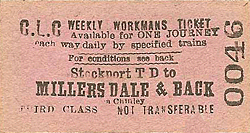 |
By the early part of the 20th century Millers Dale, and the MR route generally, had become so busy that the MR decided to invest millions of pounds into improving the line in order to aid traffic flow. In 1905 Millers Dale Station sold 46,613 tickets. [This was the highest figure in MR days, other than in 1919/20 when bookings at most stations on the line increased |
markedly, possibly due to train services and facilities being restored more-or-less to pre-war levels – although they fell away quite dramatically from 1921 as the introduction of motor bus services and falling inflation was not matched by reductions in train fares.] Many more passengers than this would have used it as an interchange point. The improvement works were carried out between 1902 and 1906. At Millers Dale an extra viaduct was constructed and the line was quadrupled. This necessitated the rebuilding of the station.
In its rebuilt form Millers Dale station was provided with five platforms, four of the platform faces being located on two island platforms.
| Platform 1 was located on the north side of the line. The main station buildings were located here. They were single storey stone built in a grand style. They provided the station's booking facilities, waiting rooms and parcels office. Unusually for a British railway station the buildings on Platform 1 also housed the Millers Dale village post office. Generous canopies |
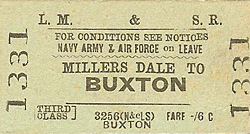 |
were also provided to protect passengers from the weather.
Platforms 2 and 3 were located on an island platform. On this platform there were single storey stone buildings that contained waiting rooms and a two storey station master's house. Canopies were also provided on this platform.
 |
Platforms 4 and 5 were also on an island platform. Again waiting facilities in the form of a single storey building with canopies were provided. Platform 5 was unlike the others, not a through platform. The line ended at a set of buffer stops at the east end of the platform. All of the platforms were linked by a subway. Platforms 1 and 4 were used by express and long |
distance services. Platform 1 was for southbound and platform 4 for northbound services. Platforms 2 and 3 were for local and stopping services. Platform 2 was used by southbound and platform 3 by northbound trains. Platform 5 was provided specifically for the Buxton shuttle services.
The rebuilt station was given new and expanded goods facilities including a new goods shed and cattle dock. The originals had been demolished to make space for the additional tracks.. They were still located on the north side of the line at the western end of the station. A signal box at the west end of the station, on the south side of the line, controlled traffic movement at the station.
By 1922 there were 43 departures from Millers Dale. Fourteen of the departures went southbound and fifteen went northwards. Services ran to Buxton, Derby, Nottingham, London, Liverpool and Manchester. The rest of the departures were the Buxton Shuttles.
| In 1923 Millers Dale became part of the London Midland and Scottish Railway (LMS). The LMS also took over the LNWR routes between Manchester and London. However so busy were all of the routes that no reductions to services on the former MR occurred. The LMS introduced ‘push and pull’ trains on the Buxton Shuttle. This made traffic movements easier as |
 |
there was no need for an engine to run around its train at its destination points.
In 1948 Millers Dale became part of the nationalized British Railways (London Midland Region). The station and the line remained busy through the 1950s and into the 1960s. Indeed service frequencies increased. In 1960 British Railways introduced the Diesel Pullman, or Blue Pullman as it became known, onto the MR route between Manchester Central and London St Pancras. Unlike most express trains the Pullman did not stop at Millers Dale. During the British Railways era Millers Dale was served by local trains running between Buxton and Derby, between Manchester and Derby and by the frequent Buxton shuttle which from 14th October 1956 was provided by DMUs. With the introduction of the DMUs the service was expanded to nineteen in each direction. Long distance services ran south to London St Pancras and north to Manchester Central and to Liverpool Central.
It came as big surprise when the withdrawal of local stopping services (with Bakewell added later to the list of stations) and, by implication, the elimination of stops on express trains at Millers Dale was proposed in the Beeching report of 1963.
 |
On 14th June 1965 the suffix ‘for Tideswell’ was dropped, so the station reverted to its pre-1889 name. Millers Dale goods depot closed on 27th August 1966 although a private siding remained in use after that date. Through goods service was withdrawn on 3rd October 1966 and on the 6th March 1967 Millers Dale Station was closed completely along with all of
|
the other stations between Matlock and Chinley. From this date local passenger services between Derby and Buxton/Manchester, and the shuttle services between Millers Dale and Buxton were both withdrawn, while express trains ceased to call at Millers Dale – the majority having stopped there hitherto. Express passenger services continued to pass until they were diverted via Chesterfield and the Hope Valley from 1st July 1968, and the line was closed from Matlock to Peak Forest Junction.. Track lifting began in 1969.
Millers Dale stations platform 1 buildings and its platforms have survived closure. In 1982 the Peak District National Park established the Monsal Trail, a long distance path that uses many miles of the former MR route including the section that passes through Millers Dale station.The surviving building is now in use as an office for the National Park Rangers and it also contains public toilets.
Sources: Lost Railways of Derbyshire by Stan Yorke. Published by Geoffrey Kingscott & The Monsal Trail then and now by Alistair Lofthouse – Ald print.
Other web sites: Peak Rail now providing a regular steam service between Matlock and Rowsley. David Hey's Collection - Transition from BR steam. Includes railway photographer ER Morten's photographic tour from Buxton - Derby.
Eight and a half miles of the Matlock - Buxton line now forms the Monsal Trail starting at Coombs Road Viaduct, one mile southeast of Bakewell and finishing at the head of Chee Dale, about three miles east of Buxton. There is a diversion round the tunnels.
Further reading: Railway from Buxton to Bakewell, Matlock and Ambergate (Scenes from the Past) by JM Bentley, 1992. Railways around Buxton by JM Bentley, 1987.
Additional source Glynn Waite. Tickets from Michael Stewart (except 9163 Bevan Price and 405 & 9587 Glynn Waite), route map drawn by Alan Young. Click here for a more detailed history of the complete closure process of the Derby - Buxton/Manchester line.
To see other stations between Manchester Central & Matlock click on the station name:Manchester Central, Chorlton-cum-Hardy, Withington & West Didsbury, Didsbury, Heaton Mersey, Cheadle Heath, Hazel Grove (Midland), Buxworth, Chinley (2nd site) STILLOPEN, Chinley (1st site), Chapel-en-le-Frith Central,
Peak Forest, Cheedale Halt, Buxton (Midland), Blackwell Mill Halt, Monsal Dale, Great Longstone, Hassop, Bakewell, Rowsley (Second site), Rowsley (First site), Rowsley South PEAK RAIL, Darley Dale,
Matlock Riverside PEAK RAIL & Matlock STILL OPEN.
See also Stockport Tiviot Dale & Stockport Portwood |




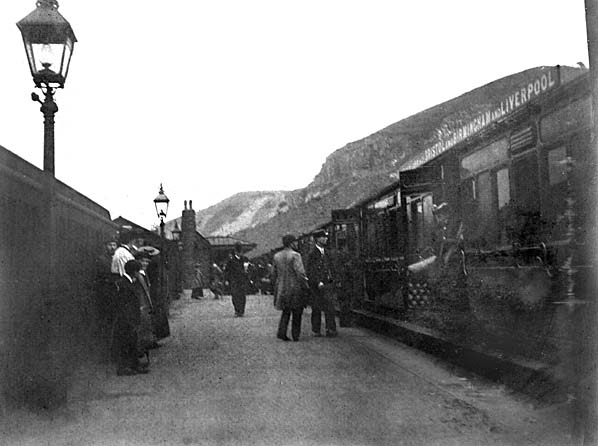
dale_old2.jpg)
dale_old10.jpg)
dale_old5.jpg)
dale_old14.jpg)
dale_old23.jpg)
dale13.jpg)
dale24.jpg)
dale3.jpg)
dale23.jpg)
dale4.jpg)
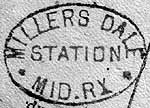











 Home Page
Home Page